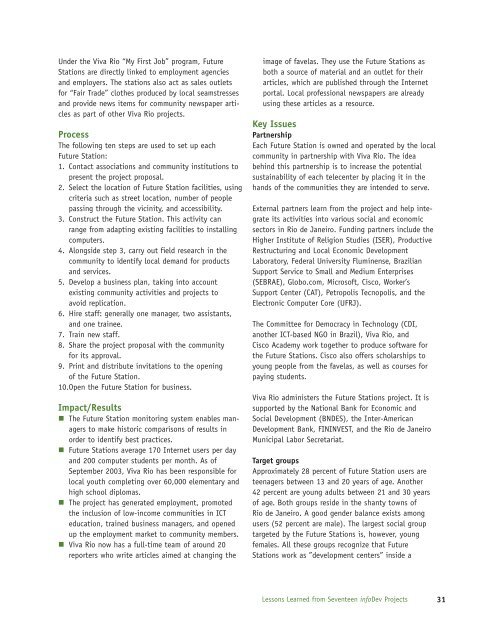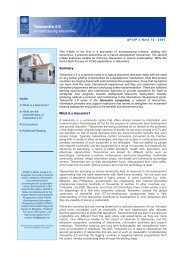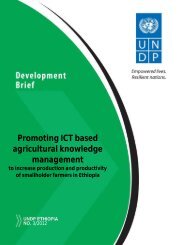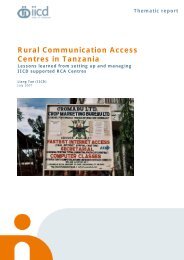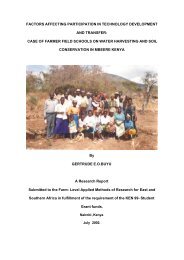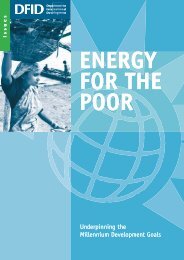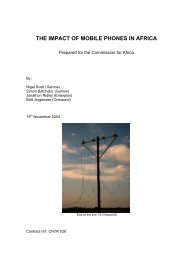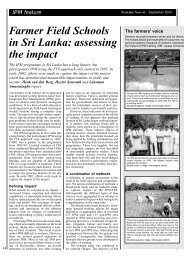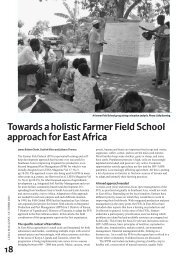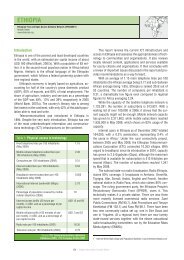ICT for Development - infoDev
ICT for Development - infoDev
ICT for Development - infoDev
You also want an ePaper? Increase the reach of your titles
YUMPU automatically turns print PDFs into web optimized ePapers that Google loves.
Under the Viva Rio “My First Job” program, Future<br />
Stations are directly linked to employment agencies<br />
and employers. The stations also act as sales outlets<br />
<strong>for</strong> “Fair Trade” clothes produced by local seamstresses<br />
and provide news items <strong>for</strong> community newspaper articles<br />
as part of other Viva Rio projects.<br />
Process<br />
The following ten steps are used to set up each<br />
Future Station:<br />
1. Contact associations and community institutions to<br />
present the project proposal.<br />
2. Select the location of Future Station facilities, using<br />
criteria such as street location, number of people<br />
passing through the vicinity, and accessibility.<br />
3. Construct the Future Station. This activity can<br />
range from adapting existing facilities to installing<br />
computers.<br />
4. Alongside step 3, carry out field research in the<br />
community to identify local demand <strong>for</strong> products<br />
and services.<br />
5. Develop a business plan, taking into account<br />
existing community activities and projects to<br />
avoid replication.<br />
6. Hire staff: generally one manager, two assistants,<br />
and one trainee.<br />
7. Train new staff.<br />
8. Share the project proposal with the community<br />
<strong>for</strong> its approval.<br />
9. Print and distribute invitations to the opening<br />
of the Future Station.<br />
10.Open the Future Station <strong>for</strong> business.<br />
Impact/Results<br />
The Future Station monitoring system enables managers<br />
to make historic comparisons of results in<br />
order to identify best practices.<br />
Future Stations average 170 Internet users per day<br />
and 200 computer students per month. As of<br />
September 2003, Viva Rio has been responsible <strong>for</strong><br />
local youth completing over 60,000 elementary and<br />
high school diplomas.<br />
The project has generated employment, promoted<br />
the inclusion of low-income communities in <strong>ICT</strong><br />
education, trained business managers, and opened<br />
up the employment market to community members.<br />
Viva Rio now has a full-time team of around 20<br />
reporters who write articles aimed at changing the<br />
image of favelas. They use the Future Stations as<br />
both a source of material and an outlet <strong>for</strong> their<br />
articles, which are published through the Internet<br />
portal. Local professional newspapers are already<br />
using these articles as a resource.<br />
Key Issues<br />
Partnership<br />
Each Future Station is owned and operated by the local<br />
community in partnership with Viva Rio. The idea<br />
behind this partnership is to increase the potential<br />
sustainability of each telecenter by placing it in the<br />
hands of the communities they are intended to serve.<br />
External partners learn from the project and help integrate<br />
its activities into various social and economic<br />
sectors in Rio de Janeiro. Funding partners include the<br />
Higher Institute of Religion Studies (ISER), Productive<br />
Restructuring and Local Economic <strong>Development</strong><br />
Laboratory, Federal University Fluminense, Brazilian<br />
Support Service to Small and Medium Enterprises<br />
(SEBRAE), Globo.com, Microsoft, Cisco, Worker’s<br />
Support Center (CAT), Petropolis Tecnopolis, and the<br />
Electronic Computer Core (UFRJ).<br />
The Committee <strong>for</strong> Democracy in Technology (CDI,<br />
another <strong>ICT</strong>-based NGO in Brazil), Viva Rio, and<br />
Cisco Academy work together to produce software <strong>for</strong><br />
the Future Stations. Cisco also offers scholarships to<br />
young people from the favelas, as well as courses <strong>for</strong><br />
paying students.<br />
Viva Rio administers the Future Stations project. It is<br />
supported by the National Bank <strong>for</strong> Economic and<br />
Social <strong>Development</strong> (BNDES), the Inter-American<br />
<strong>Development</strong> Bank, FININVEST, and the Rio de Janeiro<br />
Municipal Labor Secretariat.<br />
Target groups<br />
Approximately 28 percent of Future Station users are<br />
teenagers between 13 and 20 years of age. Another<br />
42 percent are young adults between 21 and 30 years<br />
of age. Both groups reside in the shanty towns of<br />
Rio de Janeiro. A good gender balance exists among<br />
users (52 percent are male). The largest social group<br />
targeted by the Future Stations is, however, young<br />
females. All these groups recognize that Future<br />
Stations work as ”development centers” inside a<br />
Lessons Learned from Seventeen <strong>infoDev</strong> Projects<br />
31


